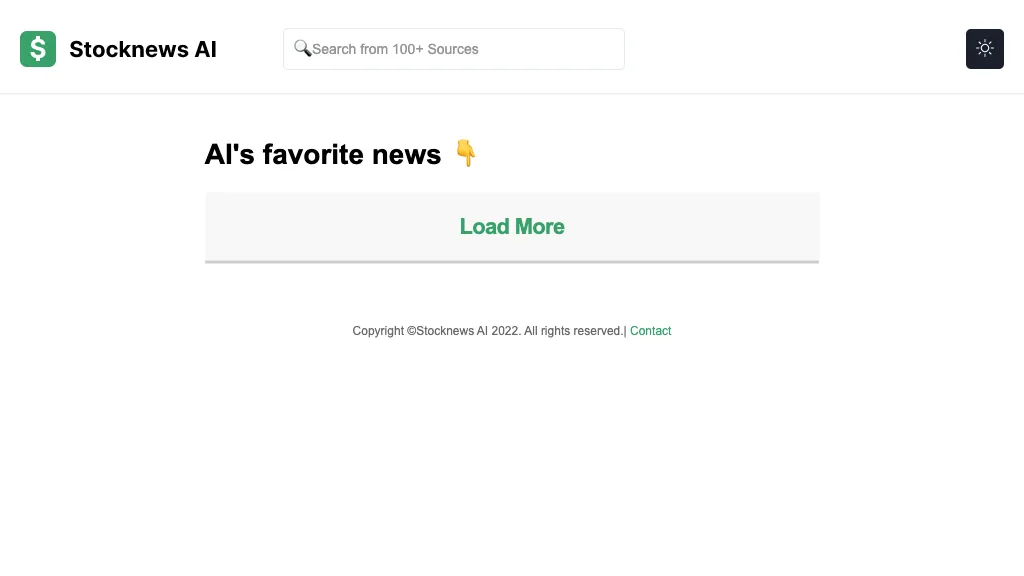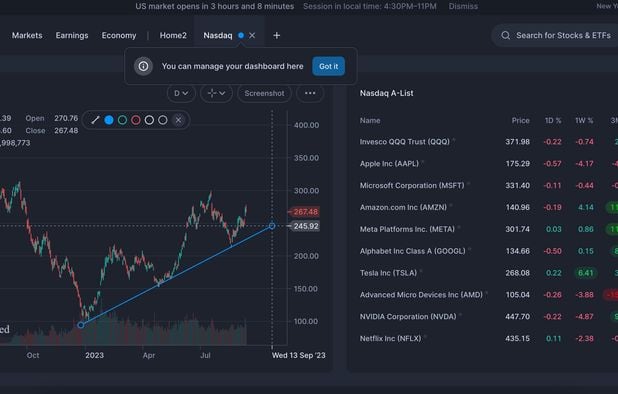Top 10 Tips For Evaluating The Integration And Compatibility Of Ai Analysis And Prediction Of Stocks Trading Platforms
AI stock Predicting/Analyzing platforms must be compatible and integrate seamlessly with existing tools, systems and workflows. Integrating your platform into the existing tools, systems, and workflows is a excellent way to improve efficiency. Here are 10 top suggestions for evaluating the compatibility and integration between these platforms.
1. Check Brokerage Integration
Supported brokers – Make sure that the platform is integrated with your brokerage or trading account.
Trade execution: Verify whether the platform supports direct trade execution using the integrated broker.
Account synchronization: Verify that the platform can sync in real time account balances and positions as well as transaction history.
2. Review API for Availability
API access: Make sure that the platform provides an API (Application Programming Interface) to allow developers to create custom tools or to automate workflows.
API documentation – Check that the API’s example and usage cases are well documented.
Rate limits: Check if there are reasonable rate limits on the API and if it can accommodate the anticipated volume of usage.
3. Review the integration of third parties
Popular tools: Check if your platform is compatible with well-known tools such as Google Sheets or Excel.
Import and export of data – Check that the platform allows for simple data export or import to/from other tools.
Plugins/extensions : Verify the platform is able to support extensions or plugins. They add features.
4. Test Compatibility Using Operating Systems
Desktop compatibility: Ensure that your platform is compatible with your operating system of choice (Windows, macOS or Linux).
Mobile compatibility: Determine if there is an application that is mobile compatible for iOS or Android.
Web-based: If you want to be flexible, verify whether your platform can be accessed via a standard web browser.
5. Evaluate Data Integration Capabilities
Data sources: Make sure whether the platform is integrated with multiple data sources (e.g. market data providers or news feeds).
Real-time feeds of data: Check if the platform allows for real-time data integration to provide up-to date analysis.
Find out if the platform is able to import data from the past.
6. Check cloud and on-premise compatibility
Cloud-based Platforms: The platform must be accessible from anywhere with an internet connection.
On-premises solutions: Check if you want to deploy the software on your premises.
Find hybrid solutions. It is a type of model that blends cloud and on-premises features.
7. Check for Cross-Platform Synchronization
Device synchronization. Check that the platform is synchronized to transfer settings and data across the devices (desktops/laptops/mobiles/tablets).
Check that changes made on one device immediately reflect on the other devices.
Examine the platform to determine whether it permits access to data or functions when you are offline.
8. Check the compatibility of trading strategies
Algorithmic Trading: Check that the platform is compatible with algorithmic or automated trading strategies.
Custom indicators. Verify if the platform allows the use of scripts or technical indicators.
Strategy backtesting: Check if the platform supports backtesting strategies for trading using historical data.
9. Examine Security and Compliance
Data encryption – Make sure that your platform is using encryption for all your data, both during transit and when it is at rest.
Verify that your platform has a secure authentication method (e.g. 2-factor authentication).
Compliance with regulatory requirements: Ensure that the platform complies to applicable regulations (e.g. GDPR, FINRA or SEC).
10. Scalability of Tests, Performance and Efficiency
Scalability: Make sure the platform can handle growing amounts of users and data as the demands of your business expand.
Performance during load: Verify whether the platform is responsive in high-volatility situations.
Utilization of resources: Ensure that your platform makes the most efficient use of the system’s resources, like memory, CPU and bandwidth.
Bonus Tips
Feedback from users: Read reviews and testimonials of users to assess the platform’s ability to integrate.
Free trial: You can try a demo or a free trial to test the compatibility of the platform to your existing workflows and tools.
Support for customers: Make sure the platform has robust support in case of integration problems.
With these suggestions, you can effectively assess the integration and compatibility of AI stock-predicting and analyzing platforms in order to ensure they are compatible with your existing systems and enhance the efficiency of your trading. Take a look at the top rated this hyperlink for site info including ai for stock predictions, ai chart analysis, ai trade, trading ai, investment ai, trading ai, options ai, ai for investment, AI stock trading bot free, incite and more.
Top 10 Tips To Evaluate The Speed And Latency Of Ai Platform For Analyzing And Stock Predicting
When evaluating AI trading platforms that can predict or analyze stock prices the speed and latency of processing are key factors, particularly for high-frequency and algorithmic traders. A delay of just milliseconds can have a negative impact on trading execution. These are the top 10 tips for evaluating the speed and latency of these platforms:
1. Real-Time data feeds are a great way to assess the accuracy of the real-time data you have
Data delivery speed: Make sure the platform delivers live data (e.g. sub-millisecond delay).
Data source proximity – Look to determine if the servers of your platform are close to important exchanges. This will cut down on the time for data transmission.
Data compression: Check if your platform utilizes efficient data compression techniques in order to accelerate data delivery.
2. Test Trade Execution Rate
Order processing: The platform’s capability to execute and process trades fast after an order is submitted.
Direct Market Access: Verify that the platform provides DMA. DMA is a feature which allows you to transmit orders directly to exchanges without intermediaries.
Execution reports: Check if the platform provides complete execution reports, which include timestamps for order submission, confirmation, and fill.
3. Assess Platform Responsiveness
User interface speed (UI): Measure how quickly the user interface of the platform responds to your inputs.
Chart updates: Make sure you check whether charts and visualizations are updated in real-time, without delay.
Performance of mobile apps When you install an app for mobile on your phone, ensure that it runs as fast as its desktop version.
4. Check for Low-Latency Infrastructure
Servers’ locations The platform should utilize high-speed, low-latency servers which are located close to major financial hubs or exchanges.
Co-location service: Find out whether your exchange offers this option. This lets you host trading algorithm on servers near to the exchange.
High-speed network: Verify whether the platform utilizes high-speed fibre optic networks, or other low latency technologies.
5. Review the results of backtesting and simulate speed
Test the speed at which your platform is able to analyze and process past data.
Simulation latency: Verify that the platform is able to simulate trading in real time without obvious delay.
Parallel processing: Make sure the platform is using parallel processing, also known as distributed computing, which speeds the process of complex calculations.
6. Check the API Latency
API responses: Find out how quickly APIs can respond to queries (e.g. retrieving data from the platform, or placing orders).
Rate limits. Check the rates of the API in order to avoid delays while high-frequency trading.
WebSocket support: Check whether the platform supports WebSocket protocols for real-time and low-latency streaming of data.
7. Test Platform Stability Under Load
High-volume trading: Play high-volume trading scenarios to assess if the platform remains steady and responsive.
Market volatility: Ensure that your platform is able to handle price fluctuations during periods of high volatility.
Utilize the tools available on the platform to stress-test your strategies under extreme conditions.
8. Assess Connectivity and Network
Internet speed needs. Ensure that your connection is at the standards for your platform to ensure optimal performance.
Reliable connections: Check if your platform has redundant internet connections. This can help you prevent downtime.
VPN latency If you’re using a VPN for connection, be sure it doesn’t introduce significant latency. Also check whether the service offers alternatives.
9. Check for Speed Enhancement Features
Pre-trade analyses The platform must provide pre-trade analysis to help optimize process of routing orders and speed up execution.
Smart order routing (SOR): Verify if the platform uses SOR to identify the fastest and cost-effective execution venues.
Latency monitoring: Determine if your platform has tools that let you analyse and monitor latency in real time.
10. Review User Feedback and Benchmarks
Feedback from users: Use reviews from users to assess the platform’s performance with regard to speed and latency.
Benchmarks provided by third party sources Find independent reviews or benchmarks that compare the speed of the platform with the speed of its rivals.
Testimonials and case studies: Find out if there are any instances that prove the platform’s low-latency abilities.
Bonus Tips
Free trial period: Test the platform’s performance and latency in real-world situations using the demo or free trial.
Support for customer – Make sure there is support available to address issues relating to latency, optimization or any other problems.
Hardware needs. Examine if a platform requires specialized hardware (e.g. a high-performance computer) in order to run at optimal speed.
Utilize these suggestions to determine the speed and latency of AI stock Predicting/Analyzing platforms. Choose a platform that suits your trading requirements and also minimizes delays. A low latency is crucial for algorithmic and high-frequency traders, where even small delays can significantly impact profit. View the best investing with ai for site recommendations including ai copyright signals, best ai trading platform, best AI stock prediction, AI stock predictions, stocks ai, best ai penny stocks, AI stock trader, how to use ai for copyright trading, ai copyright signals, stocks ai and more.
Posted inUncategorized